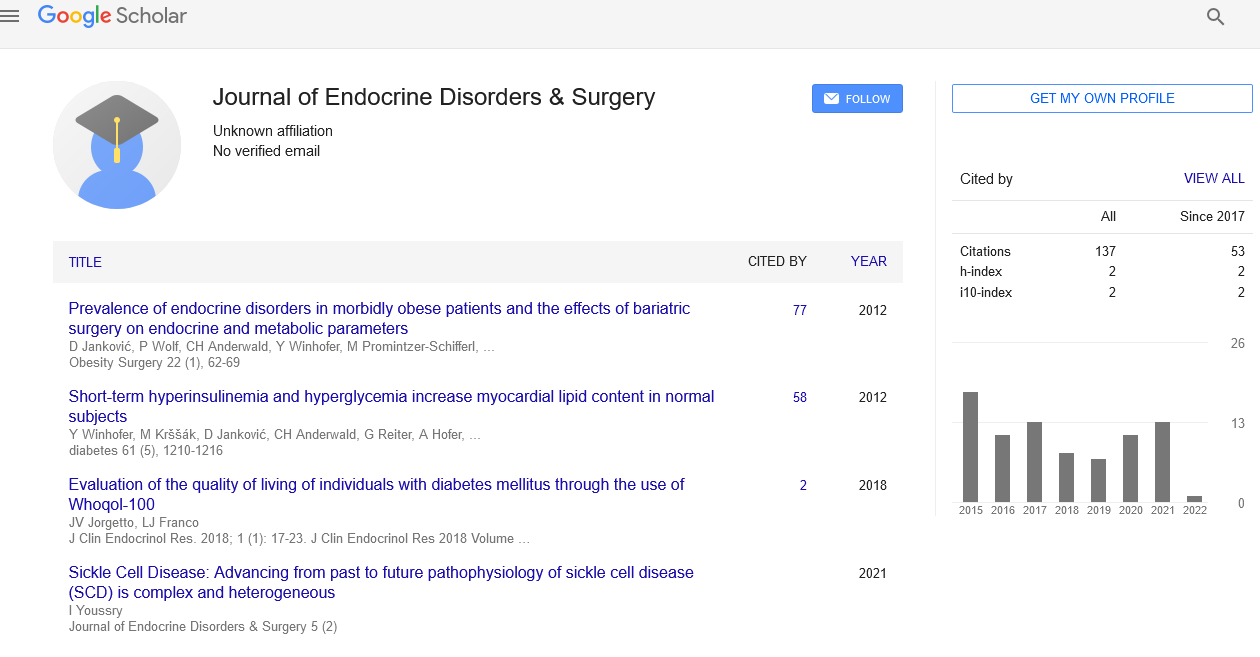Gastrointestinal surgery as a diabetes
Received: 08-Mar-2022, Manuscript No. PULJEDS-22-4633; Editor assigned: 10-Mar-2022, Pre QC No. PULJEDS-22-4633(PQ); Accepted Date: Apr 01, 2022; Reviewed: 18-Mar-2022 QC No. PULJEDS-22-4633(Q); Revised: 20-Mar-2022, Manuscript No. PULJEDS-22-4633(R); Published: 05-Apr-2022, DOI: 10.37532/ PULJEDS.22.6.2.06-07.
This open-access article is distributed under the terms of the Creative Commons Attribution Non-Commercial License (CC BY-NC) (http://creativecommons.org/licenses/by-nc/4.0/), which permits reuse, distribution and reproduction of the article, provided that the original work is properly cited and the reuse is restricted to noncommercial purposes. For commercial reuse, contact reprints@pulsus.com
Abstract
Weight loss is thought to be caused by bariatric surgery due to gastric restriction, intestinal malabsorption, or both. Adjustable gastric banding (AGB) and other restrictive surgeries limit functional stomach capacity and delay gastric emptying. Biliopancreatic diversion (BPD) is a malabsorptive operation that leaves the stomach mostly intact but diverts ingested food to the ileum, leaving just a tiny part of the colon to absorb nutrients. The usual proximal Roux-en-Y gastric bypass (RYGB) combines gastric restriction with nutritional bypass of the majority of the stomach and a short segment of the proximal intestine (mainly the duodenum); the small bowel remaining is adequate to prevent clinically severe malabsorption. Weight loss is caused by stomach constriction, as well as other mechanisms such as changes in gut hormones and other processes that are still being studied (4–15). RYGB and BPD yield the greatest and fastest rates of type 2 diabetic mellitus (T2DM) remission among bariatric operations. Several traditional bariatric surgery treatments have been shown to result in long-term remission of type 2 diabetes mellitus (T2DM); new gastrointestinal surgical approaches have also been shown to have comparable results. Other metabolic disorders, such as hyperlipidemia and hypertension, are significantly improved by these operations in both obese and nonobese individuals. Several investigations have shown evidence that these metabolic consequences are due in part to endocrine changes caused by surgical modification of the gastrointestinal system, rather than merely being the result of significant weight reduction and reduced calorie intake. We present an overview of the clinical data that shows the impact of such interventions—also known as metabolic surgery—on T2DM in this Review, as well as explore the implications for future study. We suggest that the gastrointestinal system may have a role in the pathogenesis of T2DM and obesity, based on the information given here. Several studies have shown evidence that these metabolic effects are attributable in part to endocrine changes generated by surgical gastrointestinal system modifications, rather than just being the result of large weight loss and reduced calorie consumption. In this Review, we provide an overview of the clinical evidence demonstrating the efficacy of such interventions—also known as metabolic surgery—on T2DM, as well as discuss the implications for future research. Based on the findings presented here, we believe the gastrointestinal system may have a role in the pathophysiology of T2DM and obesity. Faced with the growing worldwide diabetes pandemic, health care practitioners need as many treatment measures as they can muster. Various forms of gastrointestinal (GI) surgery, in addition to behavioural and medicinal methods, are incredibly potent choices for treating diabetes in severely obese people, sometimes stabilising blood glucose levels without the need of diabetic drugs.
Keywords
Biliopancreatic diversion; Roux-en-Y gastric bypass; metabolic surgery
Introduction
Hyperglycemia during surgery is prevalent in surgical patients and has been linked to poor results. 1 Hemoglobin glycation is caused by chronic hyperglycemia and is assessed by haemoglobin A1c (HbA1c), which indicates the average glucose level over the past 120 days. 2 HbA1c readings of 5.7 percent to 6.4 percent and greater over 6.5 percent are used by the American Diabetic Association to diagnose prediabetes and diabetes, respectively. 3 Patients with high HbA1c had higher postoperative infections and were in the hospital longer. 4,5 Hemoglobin A1c can also be used to identify individuals who are at a higher risk of developing acute postoperative hyperglycemia6, which has been associated to postoperative problems such as surgical site infections, a longer hospital stay, and death. There is no consensus in the research on whether preoperative HbA1c or postoperative hyperglycemia is better for predicting adverse outcomes after surgery. 12,15-17 Furthermore, much of the research is focused on heart surgery, which has a distinct patient group that may not be applicable to patients undergoing gastrointestinal surgery, who are at a higher risk of acquiring postoperative infections. Finally, while the association between perioperative hyperglycemia and postoperative problems has been investigated, the impact of this relationship on readmission is mainly unclear to our knowledge. Preoperative HbA1c and early postoperative glucose levels were used to predict postoperative complications and readmission. We expected that patients with an increased preoperative HbA1c are more closely monitored postoperatively, with a lower threshold of hyperglycemia for insulin administration. As a result, we evaluated postoperative glucose level monitoring and insulin therapy in patients with various preoperative HbA1c levels. We expected that raised early postoperative glucose levels would be more useful for predicting problems and readmissions than preoperative HbA1c.





